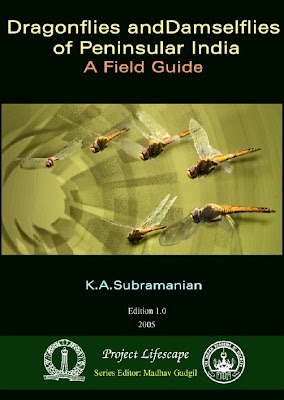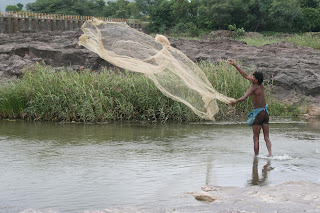short url for the story : http://goo.gl/cEVZh
 The book prepared by famous scholar K A Subramanian, who has
made extensive studies on odonates and fresh water biodiversity, was published
under the Project Lifescape of IAS in 2005. Just to make it a perfect beginners field guide, it has
pictures, and descriptions which help us identify species in a field trip. Moreover,
to suit it to any beginner, the electronic version of the book is distributed
free also.
The book prepared by famous scholar K A Subramanian, who has
made extensive studies on odonates and fresh water biodiversity, was published
under the Project Lifescape of IAS in 2005. Just to make it a perfect beginners field guide, it has
pictures, and descriptions which help us identify species in a field trip. Moreover,
to suit it to any beginner, the electronic version of the book is distributed
free also.
Nature is around us, but we need a stepping stone to enter
that world and understand its wonders. That way, dragon flies and damsel flies
are the most suitable keys t explore the wonders of the world. However, they
are numerous and are difficult to understand. This is the reason why Indian
academy of Sciences has published ‘Dragonflies and Damselflies of Peninsular
India - A Field Guide’, as a basic field guide for identifying most common
dragon flies and damsel flies seen in different parts of India.
 The book prepared by famous scholar K A Subramanian, who has
made extensive studies on odonates and fresh water biodiversity, was published
under the Project Lifescape of IAS in 2005. Just to make it a perfect beginners field guide, it has
pictures, and descriptions which help us identify species in a field trip. Moreover,
to suit it to any beginner, the electronic version of the book is distributed
free also.
The book prepared by famous scholar K A Subramanian, who has
made extensive studies on odonates and fresh water biodiversity, was published
under the Project Lifescape of IAS in 2005. Just to make it a perfect beginners field guide, it has
pictures, and descriptions which help us identify species in a field trip. Moreover,
to suit it to any beginner, the electronic version of the book is distributed
free also.
The book in its electronic version is available in three
parts with a detailed introduction which gives a clear idea about different
body parts of a damsel fly and dragon fly and also about the terms used in the field
guide to describe type specimens of each family. It also keeps detailed illustrations
which help any inexperienced dragon fly watcher to get the basics right.
As Professor Madhav Gadgil points out in the forward to the
book, “If we get to know them (odonates) better, we are apt to become more
concerned with their welfare. That, in turn would mean broader support for our efforts
to conserve, and prudently use, India’s rich heritage of biodiversity”.
We hope the field guide will thus unlock the wonder world of
nature for more people through dragon flies and damsel flies, gradually leading
them to a broader understanding about the need to conserve the rich biodiversity
on mother earth.
Download Dragonflies and Damselflies of Peninsular India - A Field Guide free from IAS's Project Lifescape page here,
Or
Download PDF files of Dragonflies and Damselflies of Peninsular India - A Field Guide from the link below.
Introduction
Dragon Flies
Damsel Flies
Or
Download PDF files of Dragonflies and Damselflies of Peninsular India - A Field Guide from the link below.
Introduction
Dragon Flies
Damsel Flies









